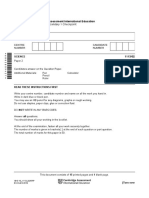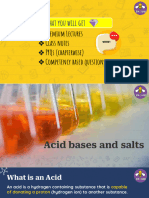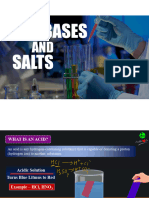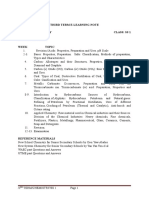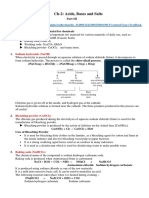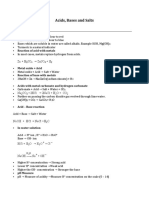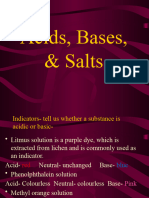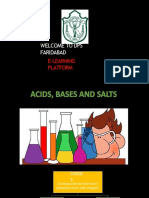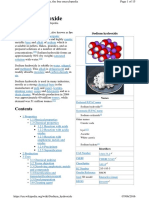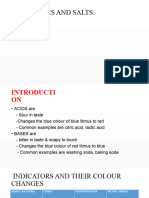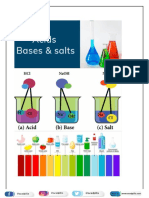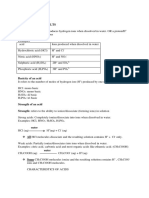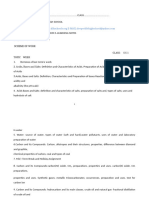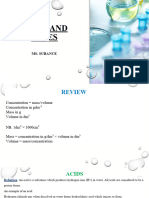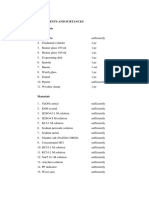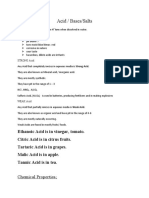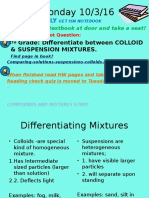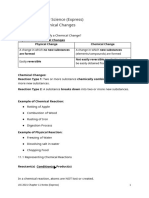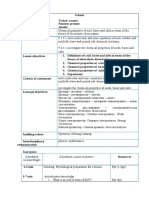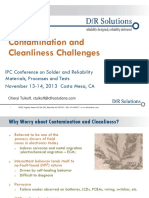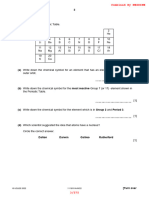0 ratings0% found this document useful (0 votes)
38 viewsMaking Salts:: Acids and Reactive Metals
Making Salts:: Acids and Reactive Metals
Uploaded by
Nur DilshadSalt is produced by the reaction of an acid with a base, forming a cation from the base and an anion from the acid. Salts dissociate into ions when dissolved or molten, making them good electrolytes. Salts can be made by reacting acids with metal carbonates, bases, or reactive metals. Common table salt (sodium chloride) is used for cooking, food preservation, and de-icing. Other important salts include sodium hydroxide for soap making, baking soda for baking powder and fire extinguishers, and plaster of Paris for setting broken bones.
Copyright:
© All Rights Reserved
Available Formats
Download as DOCX, PDF, TXT or read online from Scribd
Making Salts:: Acids and Reactive Metals
Making Salts:: Acids and Reactive Metals
Uploaded by
Nur Dilshad0 ratings0% found this document useful (0 votes)
38 views3 pagesSalt is produced by the reaction of an acid with a base, forming a cation from the base and an anion from the acid. Salts dissociate into ions when dissolved or molten, making them good electrolytes. Salts can be made by reacting acids with metal carbonates, bases, or reactive metals. Common table salt (sodium chloride) is used for cooking, food preservation, and de-icing. Other important salts include sodium hydroxide for soap making, baking soda for baking powder and fire extinguishers, and plaster of Paris for setting broken bones.
Original Title
Document - Copy
Copyright
© © All Rights Reserved
Available Formats
DOCX, PDF, TXT or read online from Scribd
Share this document
Did you find this document useful?
Is this content inappropriate?
Salt is produced by the reaction of an acid with a base, forming a cation from the base and an anion from the acid. Salts dissociate into ions when dissolved or molten, making them good electrolytes. Salts can be made by reacting acids with metal carbonates, bases, or reactive metals. Common table salt (sodium chloride) is used for cooking, food preservation, and de-icing. Other important salts include sodium hydroxide for soap making, baking soda for baking powder and fire extinguishers, and plaster of Paris for setting broken bones.
Copyright:
© All Rights Reserved
Available Formats
Download as DOCX, PDF, TXT or read online from Scribd
Download as docx, pdf, or txt
0 ratings0% found this document useful (0 votes)
38 views3 pagesMaking Salts:: Acids and Reactive Metals
Making Salts:: Acids and Reactive Metals
Uploaded by
Nur DilshadSalt is produced by the reaction of an acid with a base, forming a cation from the base and an anion from the acid. Salts dissociate into ions when dissolved or molten, making them good electrolytes. Salts can be made by reacting acids with metal carbonates, bases, or reactive metals. Common table salt (sodium chloride) is used for cooking, food preservation, and de-icing. Other important salts include sodium hydroxide for soap making, baking soda for baking powder and fire extinguishers, and plaster of Paris for setting broken bones.
Copyright:
© All Rights Reserved
Available Formats
Download as DOCX, PDF, TXT or read online from Scribd
Download as docx, pdf, or txt
You are on page 1of 3
Salt
Salt, in chemistry, substance produced by the reaction of an acid with a base. A salt consists of
the positive ion (cation) of a base and the negative ion (anion) of an acid. The reaction between
an acid and a base is called a neutralization reaction. The term salt is also used to refer
specifically to common table salt, or sodium chloride. When in solution or the molten state,
most salts are completely dissociated into negatively and positively charged ions and are
good electrolytes (conductors of electricity).
Making salts:
1. Acids and metal carbonates
When acids react with carbonates, such as calcium carbonate (found in chalk, limestone and
marble), a salt, water and carbon dioxide are made.
acid + metal carbonate → salt + water + carbon dioxide
sulfuric acid + iron(II) carbonate → iron(II) sulfate + water + carbon dioxide
H2SO4 + FeCO3 → FeSO4 + H2O + CO2
2. Acids and bases
When acids react with a base, a salt and water are made.
acid + base → salt + water
nitric acid + magnesium oxide → magnesium nitrate + water
2HNO3 + MgO → Mg(NO3)2 + H2O
3. Acids and reactive metals
Acids will react with reactive metals, such as magnesium and zinc, to make a salt and
hydrogen.
acid + metal → salt + hydrogen
hydrochloric acid + zinc → zinc chloride + hydrogen
2HCl + Zn → ZnCl2 + H2
.List of the Important Salt and their Uses:
Sodium Chloride or Common Salt (NaCl)
Used in cooking food as well as for cooking gas.
Used as a preservative in pickles and in curing meat and fish.
Used in the manufacture of soap.
Used to melt the ice in winter in cold countries.
Used for making chemical likes washing Soda, baking soda etc.
Sodium Hydroxide (NaOH)
Used for making soap and detergent
Used for making artificial textile fibre (rayon)
Used in the manufacturing of paper
Used for purification of bauxite ore
Used in de-greasing metals, oil refining and making dyes and bleaches
Baking Soda or Sodium Bi-carbonate (NaHCO3)
Used as neutralising agent (antacid)
Used for making baking powder
Used in fire extinguisher
Bleaching Powder or Calcium Hypochlorite
Used as bleaching agent in cotton industry and paper industry for bleaching cotton and linen as
well as wood pulp respectively
Used for disinfecting drinking water
Used for making chloroform (CHCl3)
Used for making the wool unshrinkable
Plaster of Paris or Hemihydrate Calcium sulphate, CaSO4 1/2 H2O
Used in hospital for setting fractured bone
Used for making toys, decoration material cheap ornament, chalk etc
Used for fire-proofing material
Used for making surface smooth. The name of the salt comes from the name of acid. For
Example- Hydrochloride acids are called Chlorides, Sulphuric Acid are called Sulphates, NitriAcid
are called Nitrates, Carbonic acid are called Carbonates, and Acetic acid are called acetates.
1https://www.britannica.com/science/salt-acid-base-reactions, /
2https://www.jagranjosh.com/general-knowledge/list-of-the-important-salts-and-their-
uses-1476361048-1
3https://www.bbc.co.uk/bitesize/guides/z7g26yc/revision/1
Nur Dilshad
You might also like
- Bitumen Emulsion NouryonDocument20 pagesBitumen Emulsion Nouryonahm21e1001No ratings yet
- Cambridge Secondary Checkpoint - Science (1113) October 2019 Paper 2Document16 pagesCambridge Secondary Checkpoint - Science (1113) October 2019 Paper 2gar wen soo64% (22)
- Class 10 Acids Bases and Salts NotesDocument22 pagesClass 10 Acids Bases and Salts NotesShreyash VishwakarmaNo ratings yet
- Screenshot 2022-11-28 at 3.28.38 PMDocument4 pagesScreenshot 2022-11-28 at 3.28.38 PMAanya AroraNo ratings yet
- Acids, Bases and Salts Notes - Part 4Document7 pagesAcids, Bases and Salts Notes - Part 4Dhyan ShahNo ratings yet
- Acid Bases and SaltsDocument38 pagesAcid Bases and SaltssajjadsafdarNo ratings yet
- Chapter-2 Acids, Bases and Salts: PropertiesDocument2 pagesChapter-2 Acids, Bases and Salts: PropertiesAkASHNo ratings yet
- Chapter 2 - Acids, Bases & SaltesDocument42 pagesChapter 2 - Acids, Bases & SaltesRufosNo ratings yet
- Chapter 2Document10 pagesChapter 2apicalsmashgetsNo ratings yet
- Notes On Salts Ch-2 Acids - Bases and SaltsDocument6 pagesNotes On Salts Ch-2 Acids - Bases and Salts23e010078No ratings yet
- Acid Base and Salts'Document4 pagesAcid Base and Salts'zaidasadsiddiquiNo ratings yet
- SALTSDocument2 pagesSALTSRatheesh HrishikeshNo ratings yet
- Types of Chemical Changes - Interactions Between MatterDocument27 pagesTypes of Chemical Changes - Interactions Between MatterStella LavenderNo ratings yet
- Acids Bases and SaltsDocument52 pagesAcids Bases and SaltsPrabakaran MNo ratings yet
- Salts PDFDocument7 pagesSalts PDFpiyushNo ratings yet
- Acids Bases and SaltsDocument4 pagesAcids Bases and SaltsMandeep SinghNo ratings yet
- Acide Bases and Salt Class 10Document16 pagesAcide Bases and Salt Class 10Abc Abc100% (3)
- FY 1 Substances in Common UseDocument5 pagesFY 1 Substances in Common Usesathvikjune2111No ratings yet
- 3RD Term S1 ChemistryDocument44 pages3RD Term S1 ChemistryRikon UchihaNo ratings yet
- Sodium Carbonate - Wikipedia, The Free EncyclopediaDocument8 pagesSodium Carbonate - Wikipedia, The Free Encyclopediad_richard_dNo ratings yet
- Chapter 7 - Acids Bases SaltsDocument38 pagesChapter 7 - Acids Bases SaltsUapi MuukuaNo ratings yet
- 07 Acids, Bases & SaltsDocument6 pages07 Acids, Bases & Saltssavidyanishitha009No ratings yet
- ACID Base by R.MDocument17 pagesACID Base by R.MSwadhinNo ratings yet
- CH 2 Class X Final NotesDocument22 pagesCH 2 Class X Final Notesavnibatra4No ratings yet
- Ch-2 Part-3Document4 pagesCh-2 Part-3Kartik BhardwajNo ratings yet
- 3 Common Indicators Natural Indicator: Acids, Bases and Salts IndicatorsDocument13 pages3 Common Indicators Natural Indicator: Acids, Bases and Salts IndicatorsJoshenderNo ratings yet
- 1 Acid:: (A) Mineral Acids (B) Organic Acids 1 (A) Mineral AcidsDocument5 pages1 Acid:: (A) Mineral Acids (B) Organic Acids 1 (A) Mineral AcidsAayushiNo ratings yet
- Class 10 Book Ncert OnlyDocument3 pagesClass 10 Book Ncert OnlyVaibhav BhardwajNo ratings yet
- 4 Acid, Base and SaltDocument8 pages4 Acid, Base and Saltjosephmartinsogbu30No ratings yet
- Acids, Bases, & SaltsDocument25 pagesAcids, Bases, & SaltsVidya JayakumarNo ratings yet
- AcidDocument8 pagesAcidmurariyadav797No ratings yet
- Acids Bases and Salts Notes PDFDocument13 pagesAcids Bases and Salts Notes PDFRajkumari MishraNo ratings yet
- Salts-1Document7 pagesSalts-1The Good BoysNo ratings yet
- Acids and Bases 0620Document4 pagesAcids and Bases 0620Gono TakaduuNo ratings yet
- 2 Acid Bases and Salts 1Document29 pages2 Acid Bases and Salts 1Tirth OzaNo ratings yet
- E-Content For Class X Science: Acids Bases and Salts (Chapter-2)Document31 pagesE-Content For Class X Science: Acids Bases and Salts (Chapter-2)Harshit GoelNo ratings yet
- ABS Complete - ChemisteryDocument71 pagesABS Complete - ChemisterymitaNo ratings yet
- 10th Acid Base and Salt Notes 2011Document5 pages10th Acid Base and Salt Notes 2011Ashraf Husain100% (4)
- Ch-2 Class X NotesDocument3 pagesCh-2 Class X NotesAshmit AnandNo ratings yet
- CHAPTER 2 Acid Base and SaltDocument37 pagesCHAPTER 2 Acid Base and SaltRaghav ParasharNo ratings yet
- 10 SC Chem AcidBaseSaltDocument9 pages10 SC Chem AcidBaseSaltAnwarYousafzaiNo ratings yet
- Acid Base Notes 20230715152315203Document7 pagesAcid Base Notes 20230715152315203NEERAV ANANDNo ratings yet
- Wiki Sodium HydroxideDocument15 pagesWiki Sodium HydroxidesaiNo ratings yet
- Acids, Bases and SaltsDocument31 pagesAcids, Bases and SaltsSharon Shymala LewisNo ratings yet
- Acid Base and SaltsDocument19 pagesAcid Base and SaltslindaoeghagharaNo ratings yet
- Acid, Bases and Salts - NotesDocument5 pagesAcid, Bases and Salts - NotespritiNo ratings yet
- Chapter 2 - Acids, Bases and SaltsDocument12 pagesChapter 2 - Acids, Bases and SaltsRAM SINGHNo ratings yet
- 2 Acid Bases and Salts 1Document31 pages2 Acid Bases and Salts 1Shivam TiwariNo ratings yet
- Acids Bases and Salts NotesDocument8 pagesAcids Bases and Salts Notesadejapeltier3No ratings yet
- Acids, Bases, Alkali NewDocument16 pagesAcids, Bases, Alkali NewnomsandaleNo ratings yet
- Acids, Bases and SaltsDocument9 pagesAcids, Bases and SaltsShalom LogosNo ratings yet
- Acid Bases-Hands OnDocument6 pagesAcid Bases-Hands Onsidharth balaji sridharanNo ratings yet
- SS1 3RD Term Chemistry E-NotesDocument114 pagesSS1 3RD Term Chemistry E-NotesaghoghouaeNo ratings yet
- Acids Bases and Salts Notes PDFDocument7 pagesAcids Bases and Salts Notes PDFMoghanram JNo ratings yet
- Acids and BasesDocument27 pagesAcids and BaseswilliamraghunananNo ratings yet
- Acids, Bases and SaltsDocument10 pagesAcids, Bases and SaltsramoselekatlegoNo ratings yet
- Na K Answer and ToolsDocument6 pagesNa K Answer and Toolsfitrah nadiaaNo ratings yet
- 10th SCIENCE (English Medium) Must DoDocument63 pages10th SCIENCE (English Medium) Must Doanshu26stNo ratings yet
- Acid & BasesDocument4 pagesAcid & BasesWaaz AmjadNo ratings yet
- The Chemistry of Fertilisers and Manure - Including Information on the Chemical Constituents and Types of Fertilisers and ManuresFrom EverandThe Chemistry of Fertilisers and Manure - Including Information on the Chemical Constituents and Types of Fertilisers and ManuresRating: 5 out of 5 stars5/5 (1)
- Progressive Resistive Exercise: Erbil Polytechnic UniversityDocument10 pagesProgressive Resistive Exercise: Erbil Polytechnic UniversityNur DilshadNo ratings yet
- YunsDocument10 pagesYunsNur DilshadNo ratings yet
- The Interview: Erbil Polytechnic University Erbil Health Technical College Physiotherapy DepartmentDocument12 pagesThe Interview: Erbil Polytechnic University Erbil Health Technical College Physiotherapy DepartmentNur DilshadNo ratings yet
- BASKDocument10 pagesBASKNur DilshadNo ratings yet
- Precipitation Titration TheoryDocument17 pagesPrecipitation Titration Theorysimonatics08No ratings yet
- CBSE 8, Science, CBSE-Materials-metals and Non-Metals, NCERT SolutionsDocument3 pagesCBSE 8, Science, CBSE-Materials-metals and Non-Metals, NCERT SolutionsSoumitraBagNo ratings yet
- Canons Yeomans TaleDocument13 pagesCanons Yeomans TaleBobbyBNo ratings yet
- Chemistry Practical 2024-25Document37 pagesChemistry Practical 2024-25agowtham506No ratings yet
- Lead AcetateDocument4 pagesLead Acetatesumathi siva100% (2)
- Chemistry SummaryDocument132 pagesChemistry SummarySebuta HuzaimaNo ratings yet
- Week 8 Grade 8 Mixtures Solutions NotesDocument45 pagesWeek 8 Grade 8 Mixtures Solutions NotesmkraemerNo ratings yet
- Ethanol PrecipitationDocument12 pagesEthanol PrecipitationАндрей ЛысенкоNo ratings yet
- Day-4 Ionic EquilibriumDocument3 pagesDay-4 Ionic EquilibriumVISHNUNo ratings yet
- Automated Management of Nutrient Solutions Based On Target Electrical Conductivity, PH, and Nutrient Concentration RatiosDocument20 pagesAutomated Management of Nutrient Solutions Based On Target Electrical Conductivity, PH, and Nutrient Concentration RatiosBachrul Ulum, SPNo ratings yet
- Principle of Common-Ion Effect and Its Application in ChemistryDocument7 pagesPrinciple of Common-Ion Effect and Its Application in ChemistryYesid Tapiero MartínezNo ratings yet
- Szekacs Darvas 2012 Forty Years With Glyphosate InTechDocument40 pagesSzekacs Darvas 2012 Forty Years With Glyphosate InTechcarlos andres arrieta palenciaNo ratings yet
- Chapter 11 - Chemical ChangesDocument6 pagesChapter 11 - Chemical ChangesChaw Wei HengNo ratings yet
- Chemistry. Grade 9. 9.1A. Chemical Properties of Acid, Bases and Salts in Terms of The Theory of Electrolytic Dissociation. LESSON PLANDocument4 pagesChemistry. Grade 9. 9.1A. Chemical Properties of Acid, Bases and Salts in Terms of The Theory of Electrolytic Dissociation. LESSON PLANAikerim DosanNo ratings yet
- Experiment 1 - Isolation of Caffeine From TeaDocument4 pagesExperiment 1 - Isolation of Caffeine From TeaKate Alyssa CatonNo ratings yet
- Cleanliness and Contamination ChallengesDocument55 pagesCleanliness and Contamination ChallengesOrbán NorbertNo ratings yet
- AP Chem Unit 4 NotesDocument6 pagesAP Chem Unit 4 Notesmail2anirudhkoneruNo ratings yet
- Module 1Q SCI 7 3Document10 pagesModule 1Q SCI 7 3PeterClomaJr.No ratings yet
- Ion Selective ElectrodeDocument9 pagesIon Selective ElectrodeRekhaNo ratings yet
- Tabla Compatibilidad Quimica: Chemical ResistanceDocument12 pagesTabla Compatibilidad Quimica: Chemical ResistanceDavid Balboa VillenasNo ratings yet
- CHM271 - Tutorial 3 - Ionic EquilibriumDocument3 pagesCHM271 - Tutorial 3 - Ionic Equilibriumfiefy zmrNo ratings yet
- Discussion SoapDocument4 pagesDiscussion SoapAh_boy100% (12)
- P5Q2 Combined CombinedDocument196 pagesP5Q2 Combined CombinedAreej NeshewatNo ratings yet
- Experiment # 2.3: Water Analysis: SolidsDocument13 pagesExperiment # 2.3: Water Analysis: Solidsshane escoteNo ratings yet
- Chlor Rid SlidesDocument47 pagesChlor Rid Slidesmohammed goudaNo ratings yet
- Anglo Chinese School Pure Chemistry Prelim 2023Document48 pagesAnglo Chinese School Pure Chemistry Prelim 2023nh24kaelonneojunanNo ratings yet
- Unit II - Lecture NotesDocument5 pagesUnit II - Lecture NotesSteve Sullivan100% (1)

